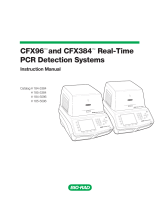Page is loading ...

For life science research only. Not for use in diagnostic procedures.
LightCycler
®
96 System Quick Guide: Programming and running an experiment
Workflow
To program and run an experiment, use:
LightCycler® 96 Application Software for defining an experiment protocol and
analyzing acquired data.
LightCycler® 96 Instrument Software for defining an experiment protocol and
performing experiments.
For detailed step-by-step information, refer to the
LightCycler® 96 System User Training Guide on the LightCycler® 96 USB Drive.
Set up the reaction mix
Define the experiment
Run the experiment
Identify the detection dye to be used in your experiment.
Prepare the PCR mix and set up the sample dilutions.
When setting up the PCR mix, you should compensate for pipetting losses. It is
recommended to prepare PCR mixes with 10% extra volume.
Run
experiment
Define
experiment
Edit
sample list
Analyze
results
Transfer experiment definition
Transfer raw data
Define
experiment
LightCycler
®
96 Application Software LightCycler
®
96 Instrument Software
1
2
Pipette the PCR mix and the corresponding sample dilution into each well of the
LightCycler
®
480 Multiwell Plate 96.
Seal the multiwell plate with the LightCycler
®
480 Sealing Foil using the sealing foil
applicator (part of the system package).
Centrifuge the multiwell plate at 1,500 x g for 2 minutes in a standard swing-bucket
centrifuge, using a rotor for multiwell plates and suitable adapters.
Create a new experiment using the LightCycler
®
96 Application Software or the
LightCycler
®
96 Instrument Software.
Open the Run Editor tab and define the temperature profile, including the heating and
cooling cycles to be used.
Configure the detection format and the sample volume.
Save the experiment.
If you have defined the experiment using the LightCycler
®
96 Application Software,
transfer the experiment file to the LightCycler
®
96 Instrument.
If the instrument is connected to an Ethernet network, use the Instrument Manager
in the application software to send the experiment file to the instrument.
If the instrument is not connected to an Ethernet network, use a USB drive to trans-
fer the experiment file to the instrument. The experiment file has to be saved into a
top level Experiments folder on the USB drive.
Insert the LightCycler
®
480 Multiwell Plate 96 with the samples into the
LightCycler
®
96 Instrument.
On the Overview tab on the touchscreen, select the experiment in the list.
3
4
5
1
2
3
4
1
2
3

For life science research only. Not for use in diagnostic procedures.
LightCycler
®
96 System Quick Guide: Programming and running an experiment
Run finished
The end of a run is indicated as follows:
The status bar on the touchscreen displays the instrument status Ready.
The LightCycler® 96 Instrument unlocks the loading module.
The experiment progress window area shows the end time of the experiment run.
The Raw Data tab provides the final raw data.
Transfer the experiment to the application software
Edit the sample list
Analyze the data
Disclaimer
Before setting up operation of the LightCycler® 96 System, it is important to read the user
documentation completely. Non-observance of the instructions provided or performing
any operations not stated in the user documentation could produce safety hazards.
In the global action bar on the right, choose the Start button.
View the Raw Data tab to monitor the progress of the running experiment.
If the instrument is connected to an Ethernet network, use the Instrument Manager
in the application software to retrieve the experiment file from the instrument.
If the instrument is not connected to an Ethernet network, use a USB drive to trans-
fer the experiment file to your computer.
Edit the experiment according to your needs and save the file to your computer.
Open the Plate View taboftheSample Editor.
Use the Clear Wells function to clear the empty wells. This eliminates the selected wells
from further analyses.
Select a well or a range of wells.
4
5
1
2
1
2
3
In the Reaction Properties window area to the right of the multiwell plate image, edit the
sample-specific properties.
Ensure that the sample assignment on the ‘Sample Editor’ tab matches the pipet-
ting scheme on the multiwell plate.
Save the experiment.
On the Analysis tab, add the appropriate analysis type.
Open the <analysis> Settings dialog box and set up the analysis-specific parameters.
Exclude samples if necessary.
Select the results to be displayed.
Optional: Export the result data.
Version Information
Version 2.0, May 2013, Software Version 1.1.
Trademarks
LIGHTCYCLER is a trademark of Roche.
© 2012 Roche Diagnostics. All rights reserved.
Published by
Roche Diagnostics GmbH
Sandhofer Straße 116
68305 Mannheim
Germany
www.roche-applied-science.com
For patent license limitations for individual products, please refer to: www.technical-support.roche.com.
4
5
1
2
3
4
5
/


